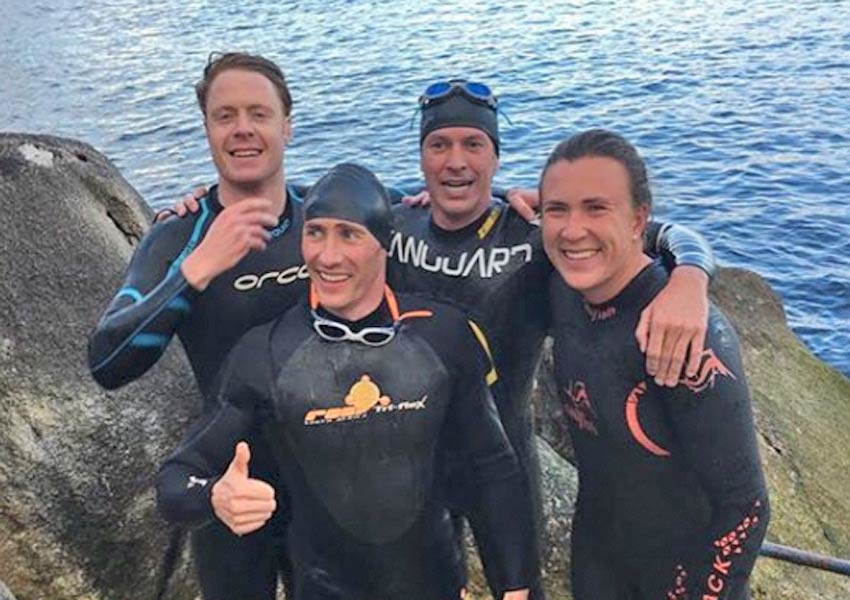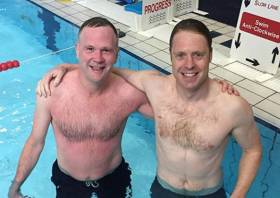Displaying items by tag: Guy O'Leary
Royal Irish Yacht Club Member Guy O'Leary is On Day 23 of His Mile A Day in May Swim In aid of Cancer Research
Royal Irish Yacht Club (RIYC member) Guy O'Leary is on day 23 of his Mile A Day in May 2024 swim supporting the Trinity College/St.James Hospital Cancer Institute- Ireland's first centre of excellence for Cancer Research.
This is the fifth year Guy and his friends have been doing these 31-mile swims, and they have raised enough money to fund 10 years of PhD Cancer Research.
As regular Afloat readers will know, Guy — son of Dun Laoghaire Marina developer and local sailing stalwart Michael O’Leary — was diagnosed with cancer after a routine check-up in November 2017 at the age of 34.
Thanks to the efforts of an “incredible surgeon” and other specialists, not to mention 11 gruelling rounds of chemotherapy, Guy has long since regained his health.
And he’s been determined to give back to those who helped keep him alive — starting with his first fundraiser in May 2019 when he swam a mile each day in May in various locations, whether in pools, inland waters or the sea.
“Having been through the horrors of cancer, I want to do everything I can to help the research effort,” Guy says. “Over the past few years, we have raised enough money to fund ten years of PhD cancer research.”
One in two of us will get cancer during our lives - these 31 miles aim to stand up to this disease.
Follow all the miles on guy.oleary on Instagram.
To support /donate - mileadayinmay2024
Dublin Bay sailor Guy O’Leary is already a third of the way into his MileADayInMay fundraiser, in which he’s challenging himself to swim a mile each day during the month of May in aid of cancer research.
And this year he will be joined by 70 swimmers both in person and around the world doing their own miles to support his important fundraising effort.
As regular Afloat readers will know, Guy — son of Dun Laoghaire Marina developer and local sailing stalwart Michael O’Leary — was diagnosed with cancer after a routine check-up in November 2017 at the age of 34.
Thanks to the efforts of an “incredible surgeon” and other specialists, not to mention 11 gruelling rounds of chemotherapy, Guy has long since regained his health.
And he’s been determined to give back to those who helped keep him alive — starting with first fundraiser in May 2019 when he swam a mile each day in May in various locations, whether in pools, inland waters or the sea.
“Having been through the horrors of cancer, I want to do everything I can to help the research effort,” Guy says. “Over the past few of years, we have raised enough money to fund 8 years of PhD cancer research.”
For the third year running Guy is fundraising both for cancer research in Ireland, which has garnered more than €12,000 already, and for Cancer Research UK which has raised another £1,900. Follow his progress on Instagram.
Dublin Bay sailor Guy O’Leary is back in the water and challenging himself again to swim a mile each day during the month of May in aid of cancer research.
Each day of the MileADayInMay! swimming challenge will see Guy joined by “someone who helped me through the rough times” to raise funds for Cancer Research UK and Cancer Clinical Research Trust Ireland.
And Guy’s final swim of the month will start outside Dun Laoghaire Harbour, finishing at the Royal Irish Yacht Club slipway.
As regular Afloat readers will know, Guy — son of Dun Laoghaire Marina developer and local sailing stalwart Michael O’Leary — was diagnosed with cancer after a routine check-up in November 2017 at the age of 34.
“My incredible surgeon performed a bowel resection straight away but a subsequent PET scan revealed the disease had spread to my liver,” he says.
“Another major operation, 11 cycles of chemo and many hard days later, I was back on my feet with clear scans and a future I thought I mightn’t have.”

Guy still wants to give back to the “brilliant” charity and the doctors and scientists it supports “who developed the diagnostics, surgical robots and chemo treatments that saved my life”.
He explains: “It is because of the skill of two amazing surgeons, an unbelievable oncologist, my amazing team of nurses, a relentlessly inquisitive wife and the work of Cancer Research that I am still alive today.
“The progress Cancer Research has made over the last three decades means that I was given a chance at survival. This was a chance my grandmother didn’t have when she fell ill with the disease in the mid-1980s.
“Having been through the horrors of cancer, I want to do everything I can to help the research effort.”
Guy has set up a website for his challenge at MileADayInMay.org which links to his fundraising site, and you can also follow his progress on Instagram.
Dun Laoghaire Harbour sailor Guy O'Leary is repeating last year's swim for charity endeavour this morning when he swims a mile each day during the month of May to raise funds for Cancer charities.
Like last year, he will be joined each day during the month by supporters that will complete the mile challenge.
In all, 70 swimmers from around the world will swim the mile and support the fundraising effort. Last year O'Leary raised €85,000 for cancer research.
As regular Afloat readers will know, O'Leary himself survived the disease after a year of treatment himself as he describes here.
 The scene last year when Guy O'Leary (centre) was congratulated by friends and supporters after completing his month of May swim at the Royal Irish Yacht Club in Dun Laoghaire Harbour
The scene last year when Guy O'Leary (centre) was congratulated by friends and supporters after completing his month of May swim at the Royal Irish Yacht Club in Dun Laoghaire Harbour
Guy's fundraising page is now live at www.mileadayinmay.org you can choose to donate to Cancer Research UK or The Irish Cancer Society.
The website also has a link at the bottom of the page to Instagram if you would like to follow the day-to-day progress of the challenge!
Guy O’Leary’s challenge to swim a mile each day during the month of May has so far raised a whopping €70,000 for Cancer Research UK.
As previously reported on Afloat.ie, Guy — son of Dun Laoghaire Marina developer and local sailing stalwart Michael O’Leary — was diagnosed with cancer after a routine check-up in November 2017 at the age of 34.
Following a lengthy period of treatment, he decided he needed to do something to pay back the medical staff and researchers — not to mention family and friends — whose support means he’s still here today.
That’s where his idea to swim a mile a day in the month of May came about.
Guy began his MileADayInMay! challenge on Wednesday 1 May with his wife Aoife, and as he continued was joined each day by “someone who helped me through the rough times”.
 Guy (left) with Annalise Murphy and friends on Day 27 of his challenge | Guy O’Leary/Instagram
Guy (left) with Annalise Murphy and friends on Day 27 of his challenge | Guy O’Leary/Instagram
These included names familiar to Afloat.ie readers such as Annalise Murphy, the Goodbodys and Kinsale’s Sam Hunt — as well as others with a closer connection to the reason for his challenge such as fellow cancer patient Jim Right Now, and his own oncology nurse Lorna Lee.
Over the month he and his swimming companions braved the chilly waters of Killiney Bay, the more comfortable environs of the Trinity College pool, and even sunny Brockwell Lido and the Olympic pool in London.
And as promised, his final mile started outside Dun Laoghaire Harbour, finishing at the Royal Irish Yacht Club slipway.
“This has been an incredible challenge for me,” he said after his last swim of the month. “Thanks to the 45 swimmers who completed a mile with me and for all the donations so far.”
As of today the total raised stands at are than £62,000 — and Guy’s fundraising campaign is still active for anyone who wants to contribute.
Guy O’Leary Is Swimming A Mile A Day In May For Cancer Research
Guy O’Leary is back on his feet after more than a year of cancer treatment — and to prove it he’s challenged himself to swim a mile each day during the month of May.
Beginning this Wednesday 1 May, each day of the MileADayInMay! swimming challenge will see Guy joined by “someone who helped me through the rough times” to raise funds for Cancer Research UK.
And Guy’s final swim of the month will start outside Dun Laoghaire Harbour, finishing at the Royal Irish Yacht Club slipway.
Guy — son of Dun Laoghaire Marina developer and local sailing stalwart Michael O’Leary — was diagnosed with cancer after a routine check-up in November 2017 at the age of 34.
“My incredible surgeon performed a bowel resection straight away but a subsequent PET scan revealed the disease had spread to my liver,” he says.
“Another major operation, 11 cycles of chemo and many hard days later, I was back on my feet with clear scans and a future I thought I mightn’t have.”
Now Guy wants to give back to the “brilliant” charity and the doctors and scientists it supports “who developed the diagnostics, surgical robots and chemo treatments that saved my life”.
He explains: “It is because of the skill of two amazing surgeons, an unbelievable oncologist, my amazing team of nurses, a relentlessly inquisitive wife and the work of Cancer Research that I am still alive today.
“The progress Cancer Research has made over the last three decades means that I was given a chance at survival. This was a chance my grandmother didn’t have when she fell ill with the disease in the mid-1980s.
“Having been through the horrors of cancer, I want to do everything I can to help the research effort.”
Guy has set up a website for his challenge at MileADayInMay.org which links to his fundraising site, and you can also follow his progress on Instagram.






























































